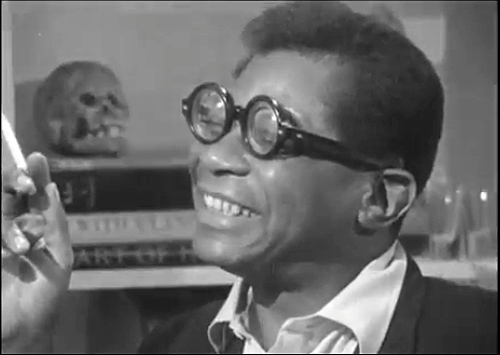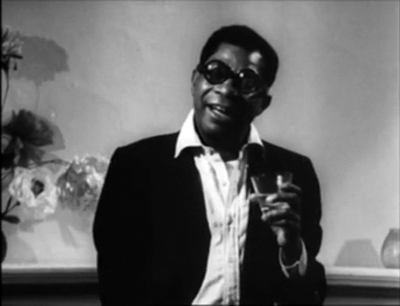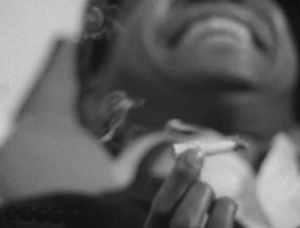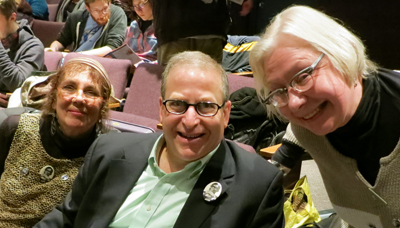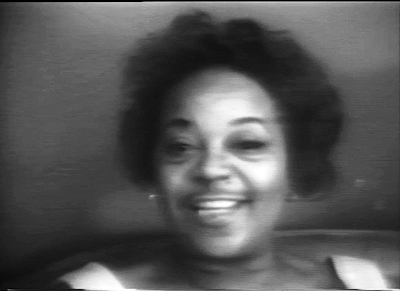I’ll never tell: JASON reborn
Sunday | March 17, 2013 open printable version
open printable version
Portrait of Jason (1967).
DB here:
A white-walled apartment; no windows visible. Screen left: a day bed wedged into the corner. Center of screen: A fireplace and mantelpiece. Screen right: an easy chair with an end table boasting a lamp and ashtray. Behind it a bookcase. It’s as colorless a performance space as you could ask for, except perhaps for the skull on a bookshelf; but even that isn’t real.
In this arena a slender black man with thick Harold Lloyd glasses and a winning smile talks to us. His first words, delivered with calm sincerity, are immediately revealed as false.
My name is Jason Holliday. My name is Jason Holliday. (Breaks into laughter.)
(With a confiding smile) My name is Aaron Payne.
Over a single night, from 9 PM to 9 AM he talks to the camera, and eventually with the unseen filmmakers. High on marijuana and drunk on single malt scotch, he recounts his life as a gay hustler, recalls his family and childhood, and offers his analysis of how to behave around whites. He strikes attitudes, mimics the slaves in Gone with the Wind, and sings show tunes.
At first the filmmakers encourage him to tell this or that story, but late in the film one offscreen voice presses him. “Why’d you write letters about me?” “You should suffer.” “You’re full of shit.” Near the end Jason is sobbing. “If you don’t know,” he says, “I love you.” The offscreen voice is pitiless: “Stop that acting.”
Portrait of Jason (1967) is a legendary film that until recently had gone astray. Last Friday our Cinematheque hosted the US premiere of the restored version. The movie tells quite a story, but so too does Dennis Doros, VP of Milestone Films and the man whose tenacity brought back this delightful, disturbing record of Jason’s long night.
In and out of focus
It was a shocker in its day. What other film talked so frankly about gay life, race relations, and drug use? Where else would you hear virtually every four-letter word in the American vernacular? Shown in festivals and independent art houses, it won an astonishing level of praise. Here is Newsweek:
Jason lives, and Jason gives one of the most incredible performances ever recorded on film. This inverted Everyman, this anti-matter Jack Armstrong has a terrible tale to tell about how much it can hurt to be human, and he tells it in magnificently rich language with the gay desperation of an artist.
But the film was doubtless worrying. It circulated in the same year as Blow-Up, Bonnie and Clyde, The Graduate, Bike Boy, In Cold Blood, I am Curious (Yellow), Rush to Judgment, and I, a Woman—a year in which studio films, exploitation, art movies, and the underground seemed to be joyously blitzkrieging conventional values and good taste. Portrait of Jason opened at the New York Film Festival after a summer in which American cities had been shaken by riots in black neighborhoods. Now came a film in which a black man blithely reveals the cynicism behind his shuck-and-jive for rich white employers. And he’s a gay prostitute.
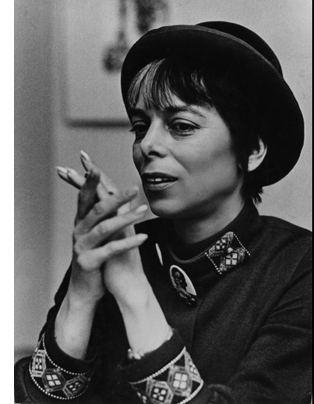 The director, Shirley Clarke, was a member of the New American Cinema group around the Film-Makers Coop and the magazine Film Culture, but she never fitted into any clear-cut category. She made dance films and some lyrical shorts like the zesty Bridges Go Round (1958), but she never joined the avant-garde tradition typified by Stan Brakhage, Michael Snow, and Ernie Gehr.
The director, Shirley Clarke, was a member of the New American Cinema group around the Film-Makers Coop and the magazine Film Culture, but she never fitted into any clear-cut category. She made dance films and some lyrical shorts like the zesty Bridges Go Round (1958), but she never joined the avant-garde tradition typified by Stan Brakhage, Michael Snow, and Ernie Gehr.
Her other feature-length films (The Cool World, The Connection) owed something to American cinéma vérité. Variety sourly remarked of Jason, “C’est la vérité,” and ran its review alongside a review of Frederick Wiseman’s Titicut Follies. But Clarke’s daughter Wendy recalls that although Shirley was friends with vérité filmmakers, she doubted that they could capture reality objectively. Leacock and Pennebaker would have found it impure to jab their own comments into the subject’s monologue the way Clarke and her lover Carl Lee do. Clarke’s approach is closer to that of the French cinéma direct, as pioneered by Jean Rouch and Chris Marker. In Le joli mai (1963) the filmmakers ask their interviewees frankly: “Are you happy?” This question underlies Portrait of Jason too.
Apart from the coaxing and goading interjections, Clarke’s filming method seems artless. There are fewer than fifty shots in 105 minutes, and they’re linked by black frames and out-of-focus passages. Both transitions mimic casual shooting. Yet Dennis Doros and Wendy Clarke pointed out that Clarke loved cutting. She was aware of the paradox:
I had enormous patience in terms of editing and I’ve always adored that part of making films, and in an odd way as I develop as a director I set up less and less situations to edit. The better I’ve become as a director, the less editing, the more I’m thinking in terms of the last twenty or thirty minutes that will have no editing at all.
In Jason the cutting isn’t as casual as it might seem. The blurry passages conceal edits, and the order of scenes doesn’t reflect the progress of the shoot. It will take patient research to determine the original chronological order of the reels we see. Clarke claimed that she enjoyed editing because at that phase she was really discovering her film.
Clarke’s apparently loose shooting, often running the camera until the magazine is empty, may seem a version of Warhol’s static films like Eat. It seems likely that she also learned from Warhol’s approach to performance. His psychodrama-based dramaturgy, as explained in J. J. Murphy’s fine book, constantly hovers between confession and put-on, and this is central to what happens in Clarke’s film. But Clarke gives her movie a more clear-cut narrative contour than Warhol would, with Jason’s monologue devolving from grinning self-assurance to stricken self-exposure.
Clarke and her crew acknowledge the act of filming, although they don’t emerge from behind the camera, as some do in The Connection. This recognition of artifice can encourage the subject to perform, to play up to the camera for the approval of the filmmakers and the audience. And a chance to perform is exactly what Jason wants. Now, he chortles, he can show off the nightclub act he’s been working on. The film is at once an audition and an effort to define himself. He’ll create “a picture I can save forever—one beautiful something that’s my own.”
So in the stage space between the day bed and the armchair, he strolls and poses. He fires off randy one-liners like “If I’d been a ranch, I’d be called Bar None.” Flipping his boa, he channels Mae West, Butterfly McQueen, Dorothy Dandridge, and Harry Belafonte. (Did he rename himself in honor of Judy Holliday?) He jiggles ice cubes in his glass with the winking panache of Dean Martin at the Sands. Clarke once said that in watching the rushes she was reminded of her choreography films: Jason seemed to be dancing.
To recover from his numbers, Jason flings himself offstage, flopping back on the daybed or sinking into the armchair as his cigarette burns down to the filter. In these moments, he seems to be candid. He admits that even with all the money he’s borrowed from friends, he’s not ready to take the show-business plunge. Drunk and giggling, he tells of childhood beatings with a razor strop: you mustn’t stick your butt up high but press yourself against the bed; that hurts less. His oscillations of mood are dislocating, passing from exuberance to frankness to self-mockery. Moments of self-celebration (“I’m a male bitch”) can also seem inadvertent glimpses of vulnerability–which may be exactly what Jason wants us to think. At one level Jason gives lessons in impression management.
I see his tears at the climax as born of authentic pain, but I can’t be sure. Earlier in the film he bragged: “When I do my pathetic bag, I’m really pathetic.” The layers of Jason’s one-queen show seem endless. Clarke said in an interview that everything he does on film—his jokes, stories, even the weeping—she had seen many times before. “His entire life is a role.” He seems to spill everything, but one of his mottos, delivered with finger snaps, is: “I’ll never tell.”
Treasure hunt
Wendy Clarke, Dennis Doros, and Maxine Fleckner Ducey.
How was this extraordinary film brought to light again? That was the story Dennis Doros told at our departmental colloquium the day before the screening. His company Milestone has specialized in reviving forgotten or neglected films of all types, including American independent work like Kent MacKenzie’s The Exiles and Charles Burnett’s Killer of Sheep. Simply trying to get a quality version of Portrait of Jason took him on a hunt that revealed, after many twists, that the closest thing to an original print was residing here in Madison, Wisconsin.
Back in the 1960s and early 1970s, our Wisconsin Center for Film and Theater Research made an effort to collect off-Hollywood cinema, including the works of East Coasters like Emile de Antonio, Doris Chase, and Shirley Clarke. Clarke’s collection, like several others, harbors vast amounts of personal papers and film material.
Clarke shot Jason on 16mm, but no negative has yet been found. There were 35mm prints made, and some wound up in archives, notably at the Museum of Modern Art. But among the material Clarke began giving the Center in 1973 were six reels of silent 16mm footage and several reels of sound recording. When they were inspected, the reels were believed to be either outtakes or stretches of a rough cut. We didn’t yet have a release print of Jason to compare them to.
Many years later, after searching high and low across the world, Dennis had the good idea of adding up the footage counts of our reels. The length was four minutes longer than the final running time of the film. After further research, our footage was revealed as Clarke’s original cut of summer 1967, which was trimmed and revised for the film’s official premiere at the New York Film Festival. This was, says Dennis, “the great irony in the search. Because Shirley Clarke had created a film that was meant to look unedited—filled with out-of-focus shots and black leader—Shirley’s 16mm fine-grain master was hidden all these years as outtakes!”
Our archivist Maxine Fleckner Ducey assisted Dennis throughout his quest. They found that the sound material, alas, was indeed outtakes, and Dennis still needed a good 35mm print of the Film Festival/release version for sound and final checking. More hunting ensued. Searching through the WCFTR collection, Dennis found an old telegram from Jacques Ledoux of Belgium asking permission to borrow a print from the Swedish Film Institute. Dennis contacted Jon Wengstrom at that archive, and soon he had a copy that could guide the restoration.
The whole process was enabled by funding from the Academy and from a Kickstarter campaign. To support that effort, Dennis and his wife and business partner Amy Heller made a video that traces their search for Jason. Their restored version had its world premiere at the Berlin Film Festival, and it will go on to other festivals and selected theatres. The image and sound quality far surpasses that of earlier versions in circulation.
A sort of epilogue came when Dennis and Wendy Clarke visited Madison last week. They dipped into Shirley’s vast collection, and in only two days they found treasures of a personal as well as professional nature. Perhaps some of their discoveries will surface as bonus materials on the eventual DVD release. Dennis and Wendy stayed on to introduce Friday’s premiere and take questions.
A charming pendant to Jason was the screening of a half-hour of Wendy’s Love Tapes series. In the 1970s Shirley shifted to making videos, and Wendy followed her path and became a major video artist. The series began as Wendy’s video diaries, but in 1977 she began recording people talking about what love means to them. Each person sat alone in a room, seeing her or his image on the monitor, and talked for three minutes. Over the years, the formats shifted from reel-to-reel tape to VHS to DVD, but the theme remained the same.
Wendy now has over 2500 tapes, shot in museums, schools, shopping malls, prisons, centers for battered women, and even in a booth at the World Trade Center. Ideally, she says, everyone on the planet should make one—a goal that isn’t so far-fetched thanks to smart phones and the Internet.
The Love Tapes assembly we saw with Jason was broadcast on PBS in 1982, and it was alternately grave and exhilarating. People celebrated love they’ve found but also mourned its passing and reflected on how it shaped their lives. Wendy has tried other themes, notably death, but love works best. “You talk about everything in it.” Sort of what happens in Jason too.
Thanks to Wendy Clarke and Dennis Doros for their visit to Madison, and to Jim Healy for facilitating it. Thanks also to Joe Lindner and Mike Pogorzelski, two graduates of our program, for enabling the Academy to take part in Milestone’s project. Maxine Fleckner Ducey was a great help on the Milestone project and, on a daily basis, makes us proud to have the WCFTR connected to our program. Thanks as well to current WCFTR director Vance Kepley for background information on the Clarke collection.
Project Shirley recently won Milestone an award from the National Society of Film Critics (the company’s sixth). Look for more Project Shirley material to surface from our holdings. And who, as Dennis asked in colloquium, will write the first book on this remarkable artist?
I drew Clarke’s comments about editing from Gretchen Berg, “An Interview with Shirley Clarke,” Film Culture 44 (Spring 1967), 55; and “A Conversation—Shirley Clarke and Storm de Hirsch,” Film Culture 46 (Autumn 1967), 47. The Newsweek review of Jason appeared in the issue of 6 November 1967, and the Variety review appeared on 25 October 1967.
The trailer for the new version of Jason is here; it includes side-by-side comparison of an archived 35mm print and the restoration. Clarke’s discussion of Jason’s role-playing is captured in an episode of the TV series Cinéastes de notre temps, by Noël Burch and André S. Labarthe. You can watch it here.
On The Connection, see J. Hoberman’s lively introduction on the New York Review of Books blog. Jason is a prototype of the portrait genre of documentary, a subject covered with care in Paul Arthur’s essay, “Identity and/as Moving Image,” Line of Sight: American Avant-Garde Film since 1965 (University of Minnesota Press, 2005), 24-44.
A sample of Wendy Clarke’s Love Tapes is here.
Love Tapes (1982).












